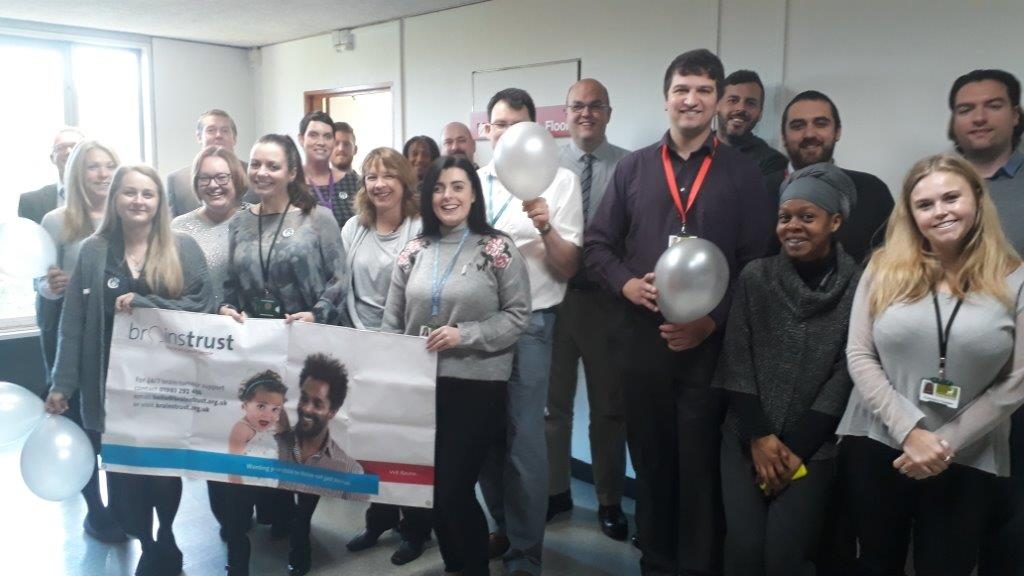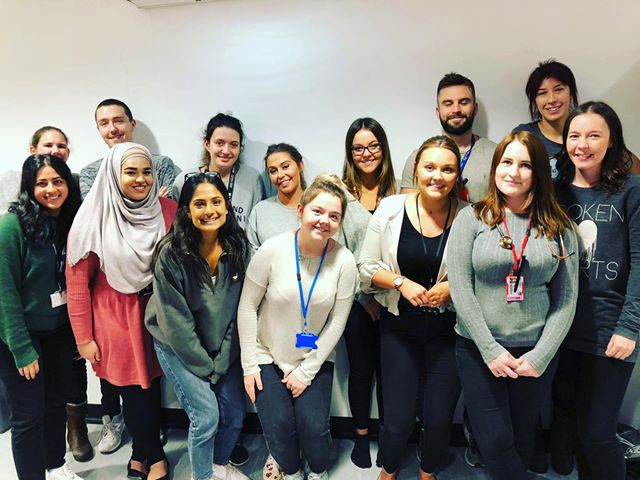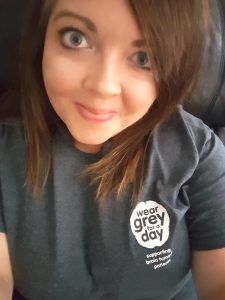Wear Grey For A Day – A Huge Success!
On Monday 1st October, we wore grey. We wore grey to raise funds and awareness for brain tumours. To tell the world about the impact a devastating brain tumour diagnosis can have, and the ‘invisible’ challenges that a brain tumour brings. Challenges such as memory loss, fatigue and loss of identity.
This year, thousands took part in Wear Grey. Together, we drove the conversation on brain tumours, and raised thousands of pounds to support people with brain tumours.

Caren Dowsett and her colleagues at WSP – Herfordshire County Council took part in Wear Grey following the support brainstrust gave Caren when she was diagnosed with a brain tumour over 5 years ago.
Wear Grey for a Day 2018 – the numbers
- Over £14,000 raised to support brain tumour patients – so far!
- 235 Wear Grey fundraising packs sent!
- Over 2000 participants!
- 5000 Wear Grey stickers!
- 357 brainstrust grey ribbon pins!
- 126 brainstrust wristbands!
- 192 text donations – raising over £1,000!

Tell us how you spent Wear Grey
One of our favourite things about Wear Grey for a Day is hearing the many wonderful ways you have taken part, and seeing photos of our supporters wearing grey. If you took part in Wear Grey at home, in your school or at your workplace, then we’d love to see and hear how it went! Please email Ryan and tell him all about your Wear Grey!

Laura Hunter chose to Wear Grey in memory of her uncle, and following the support she has received from brainstrust following her own diagnosis with a brain tumour.
How to pay in your fundraising
All the money raised by Wear Grey for a Day goes to supporting brain tumour patients following a devastating brain tumour diagnosis. If you fundraised as part of Wear Grey, paying in your funds is simple. You can do this by bank transfer, cheque or use Just Giving – whichever is the easiest for you.
For more information on how to pay in your donations by cheque or bank transfer, this can be done on the Donate section of our website. And if it would be easier for you to pay in your fundraising on Just Giving, this can be done by clicking here.

Steph Richards and her fellow students at Newcastle Medical School wore grey in support of her husband and all those suffering from brain cancer.
Still time to donate!
If you were unable to take part in Wear Grey but would like to donate, or if you took part and haven’t already done so, then don’t worry – there’s still time to donate! And remember, every penny raised goes towards supporting brain tumour patients, helping them to feel less alone, less afraid and better supported.

Kymmy’s Story
On 1st October, Kymberley Byrne took part in her first Wear Grey. Here, she tells us why she took part, and what Wear Grey and brainstrust mean to her.
‘On May 26th 2018, I married my best friend. Less than a month later, we were shaken with the news that I had a large brain tumour. As newlyweds, we didn’t expect to be having these life changing conversations so soon. On 23rd July, I had an emergency Craniotomy to remove the tumour, and had a Cranioplasty to replace ¼ of my skull.
Prior to surgery, I was a lively and sociable person, but after the surgery, I completely lost myself. I had to learn to use my limbs again, generated a stutter, was always tired, had terrible memory loss and was angry all the time. Then I found brainstrust and received my free brain box. Receiving this, and joining the brainstrust Facebook support group was the turning point for me.
Wear Grey for a Day for me was inspiring and therapeutic for me. I even decided to fundraise, despite recovering from my fourth surgery of the year. I woke up on 1st October to an amazing ‘Wear Grey’ newsfeed, where friends and family as far away as Canada and Vietnam wore grey for the day, and got their workplaces involved too. This sparked an awesome domino effect, creating a huge amount of awareness.
With the support of my husband, our families, my work colleagues and my amazing friends, we were able to raise a fantastic £2,261 for Wear Grey for a Day. I would not be where I am now if it was for the brainstrust support network. I am no longer scared or nervous to talk about my story, and I am so proud of my scars. I have become more determined, and I have found a strength that I never knew I had. Thank you everyone for your kindness and generosity for Wear Grey for a Day 2018, here’s to 2019!’







